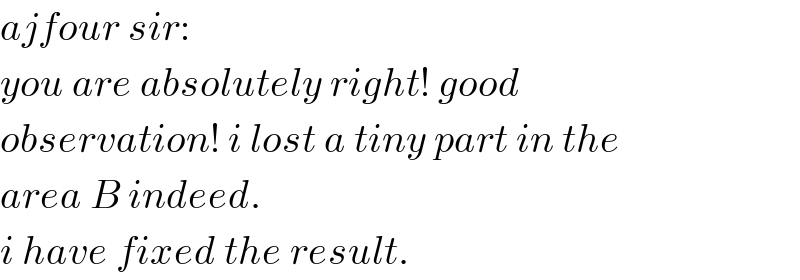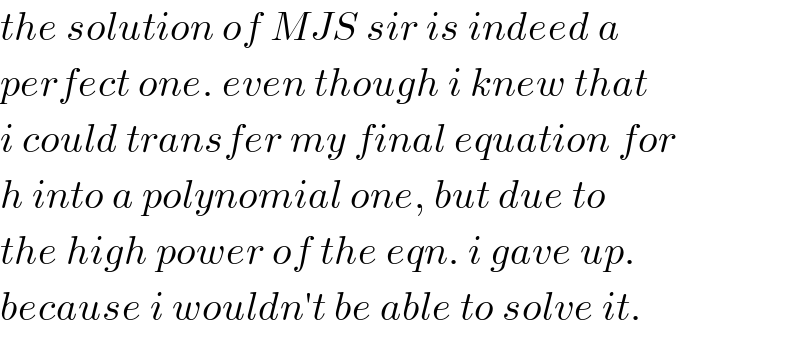
Question and Answers Forum
Question Number 64709 by ajfour last updated on 20/Jul/19

Commented by ajfour last updated on 20/Jul/19

Answered by mr W last updated on 22/Jul/19
![say both touch at point P(−h,h^2 ) y=x^2 (dy/dx)=2x eqn. of red parabola: x=−s+(y−t)^2 ⇒y=t±(√(x+s)) (dx/dy)=2(y−t) ⇒(dy/dx)=(1/(2(y−t))) at point P: −h=−s+(h^2 −t)^2 m=−2h=(1/(2(h^2 −t))) ⇒t=h^2 +(1/(4h)) ⇒s=h+(1/(16h^2 )) intersection of parabolas: x=−s+(x^2 −t)^2 ⇒x^4 −2tx^2 −x+t^2 −s=0 ⇒x^4 −(2h^2 +(1/(2h)))x^2 −x+(h^4 −(h/2))=0 (x+h)^2 (x^2 +qx+r)=0 (x^2 +2hx+h^2 )(x^2 +qx+r)=0 x^4 +(2h+q)x^3 +(h^2 +r+2hq)x^2 +(h^2 q+2hr)x+h^2 r=0 ⇒2h+q=0⇒q=−2h ⇒h^2 +r+2hq=−2h^2 −(1/(2h)) ⇒h^2 q+2hr=−1 ⇒h^2 r=h^4 −(h/2)⇒r=h^2 −(1/(2h)) h^2 +r+2hq=h^2 +h^2 −(1/(2h))−4h^2 =−2h^2 −(1/(2h))⇒ok h^2 q+2hr=−2h^3 +2h(h^2 −(1/(2h)))=−1⇒ok ⇒x^2 −2hx+h^2 −(1/(2h))=0 ⇒x=h±(√(h^2 −(h^2 −(1/(2h)))))=h±(1/(√(2h))) A=∫_(−h) ^(h−(1/(√(2h)))) [t−(√(x+s))−x^2 ]dx =[tx−(2/3)(x+s)^(3/2) −(1/3)x^3 ]_(−h) ^(h−(1/(√(2h)))) =(h^2 +(1/(4h)))(2h−(1/(√(2h))))−(2/3)(h−(1/(√(2h)))+h+(1/(16h^2 )))^(3/2) +(2/3)(−h+h+(1/(16h^2 )))^(3/2) −(1/3)(h−(1/(√(2h))))^3 −(1/3)h^3 =(h^2 +(1/(4h)))(2h−(1/(√(2h))))−(2/3)(2h−(1/(√(2h)))+(1/(16h^2 )))^(3/2) +(2/3)((1/(16h^2 )))^(3/2) −(1/3)(h−(1/(√(2h))))^3 −(1/3)h^3 A+B=∫_(−h) ^(h+(1/(√(2h)))) [t+(√(x+s))−x^2 ]dx+∫_(−s) ^(−h) 2(√(x+s))dx =[tx+(2/3)(x+s)^(3/2) −(1/3)x^3 ]_(−h) ^(h+(1/(√(2h)))) +(4/3)[(x+s)^(3/2) ]_(−s) ^(−h) =(h^2 +(1/(4h)))(2h+(1/(√(2h))))+(2/3)(h+(1/(√(2h)))+h+(1/(16h^2 )))^(3/2) −(2/3)(−h+h+(1/(16h^2 )))^(3/2) −(1/3)(h+(1/(√(2h))))^3 −(1/3)h^3 +(4/3)((1/(16h^2 )))^(3/2) =(h^2 +(1/(4h)))(2h+(1/(√(2h))))+(2/3)(2h+(1/(√(2h)))+(1/(16h^2 )))^(3/2) −(2/3)((1/(16h^2 )))^(3/2) −(1/3)(h+(1/(√(2h))))^3 −(1/3)h^3 +(4/3)((1/(16h^2 )))^(3/2) A+B=2A (h^2 +(1/(4h)))(2h+(1/(√(2h))))+(2/3)(2h+(1/(√(2h)))+(1/(16h^2 )))^(3/2) −(2/3)((1/(16h^2 )))^(3/2) −(1/3)(h+(1/(√(2h))))^3 −(1/3)h^3 +(4/3)((1/(16h^2 )))^(3/2) =2(h^2 +(1/(4h)))(2h−(1/(√(2h))))−(4/3)(2h−(1/(√(2h)))+(1/(16h^2 )))^(3/2) +(4/3)((1/(16h^2 )))^(3/2) −(2/3)(h−(1/(√(2h))))^3 −(2/3)h^3 ⇒(h^2 +(1/(4h)))((3/(√(2h)))−2h)+(2/3)(2h+(1/(√(2h)))+(1/(16h^2 )))^(3/2) +(4/3)(2h−(1/(√(2h)))+(1/(16h^2 )))^(3/2) −(2/3)((1/(16h^2 )))^(3/2) −(1/3)(h+(1/(√(2h))))^3 +(2/3)(h−(1/(√(2h))))^3 +(1/3)h^3 =0 ⇒h=2.55781774 ⇒h^2 =6.542431 eqn. of red parabola: ⇒x=−h−(1/(16h^2 ))+(y−h^2 −(1/(4h)))^2 i.e. x=−2.5673708+(y−6.6401712)^2 or x=y^2 −13.280342y+41.524503](Q64738.png)
Commented by MJS last updated on 21/Jul/19

Commented by MJS last updated on 21/Jul/19
![I tried it similar but mirrored at y=x parabola 1: y^2 =x parabola 2: y=(x−p)^2 −q I put the tangential point as ((α),((−(√α))) ) this leads to (α)^(1/4) in some terms so I put α=β^4 I get these equations: parabola 1: y=±(√x) parabola 2: y=x^2 −((4β^6 +1)/(2β^2 ))x+((β^2 (2β^6 −1))/2) I get these points of interest: P_1 = (((β^4 −(√2)β+(1/(2β^2 )))),((β^2 −((√2)/(2β)))) ) [1^(st) intersection] P_2 = (((((4β^6 +1)/(4β^2 ))−((√(16β^6 +1))/(4β^2 )))),(0) ) [1^(st) zero] P_3 = ((β^4 ),((−β^2 )) ) [2^(nd) intersection] P_4 = (((((4β^6 +1)/(4β^2 ))+((√(16β^6 +1))/(4β^2 )))),(0) ) [2^(nd) zero] P_5 = (((β^4 +(√2)β+(1/(2β^2 )))),((β^2 +((√2)/(2β)))) ) [3^(rd) intersection] the equation of the integrals then leads to β^(12) −3(√2)β^9 +(3/4)β^6 −((3(√2))/8)β^3 +(1/(64))=0 [ignoring an absolute value ⇒ β≥(1/(2)^(1/6) )≈.890899 ⇒ α≥(1/(4)^(1/3) )≈.629961] β=(t)^(1/3) ; β≥(1/(2)^(1/6) )>0∧t≥(1/(√2))>0 t^4 −3(√2)t^3 +(3/4)t^2 −((3(√2))/8)t+(1/(64))=0 I solved this with my usual method putting (t−a−(√b))(t−a+(√b))(t−c−(√d))(t−c+(√d))=0 and got a=−1+((3(√2))/4) b=2−((3(√2))/2) c=1+((3(√2))/4) d=2+((3(√2))/2) t∈R∧t≥(1/(√2)) ⇒ t=1+((3(√2))/4)+((√(8+6(√2)))/2) ⇒ β=(t)^(1/3) ⇒ α=(t^4 )^(1/3) β=((1+((3(√2))/4)+((√(8+6(√2)))/2)))^(1/3) ≈1.59932 α=((((4481)/(64))+((99(√2))/2)+((3(65+46(√2))(√(4+3(√2))))/8)))^(1/3) ≈6.54243 parabola 2: y=x^2 −13.2803x+41.5245](Q64795.png)
Commented by mr W last updated on 22/Jul/19

Commented by MJS last updated on 22/Jul/19
![(h^2 +(1/(4h)))((3/(√(2h)))−2h)+(2/3)(2h+(1/(√(2h)))+(1/(16h^2 )))^(3/2) +(4/3)(2h−(1/(√(2h)))+(1/(16h^2 )))^(3/2) −(2/3)((1/(16h^2 )))^(3/2) −(1/3)(h+(1/(√(2h))))^3 +(2/3)(h−(1/(√(2h))))^3 +(1/3)h^3 =0 we know h>0 2h+(1/(√(2h)))+(1/(16h^2 ))=(((4(√2)h(√h)+1)/(4h)))^2 2h−(1/(√(2h)))+(1/(16h^2 ))=(((4(√2)h(√h)−1)/(4h)))^2 [believing 4(√2)h(√h)−1>0 ⇒ h>((2)^(1/3) /4)≈.314980] ⇒ the equation can be transformed to −((64h^6 −192(√2)h^(9/2) +48h^3 −24(√2)h^(3/2) +1)/(48h^3 ))=0 h^6 −3(√2)h^(9/2) +(3/4)h^3 −((3(√2))/8)h^(3/2) +(1/(64))=0 h=β^2 [β>0] β^(12) −3(√2)β^9 +(3/4)β^6 −((3(√2))/8)β^3 +(1/(64))=0 ... it′s the same as my solution](Q64839.png)
Commented by mr W last updated on 22/Jul/19

Commented by ajfour last updated on 22/Jul/19

Commented by ajfour last updated on 22/Jul/19

Commented by mr W last updated on 22/Jul/19

